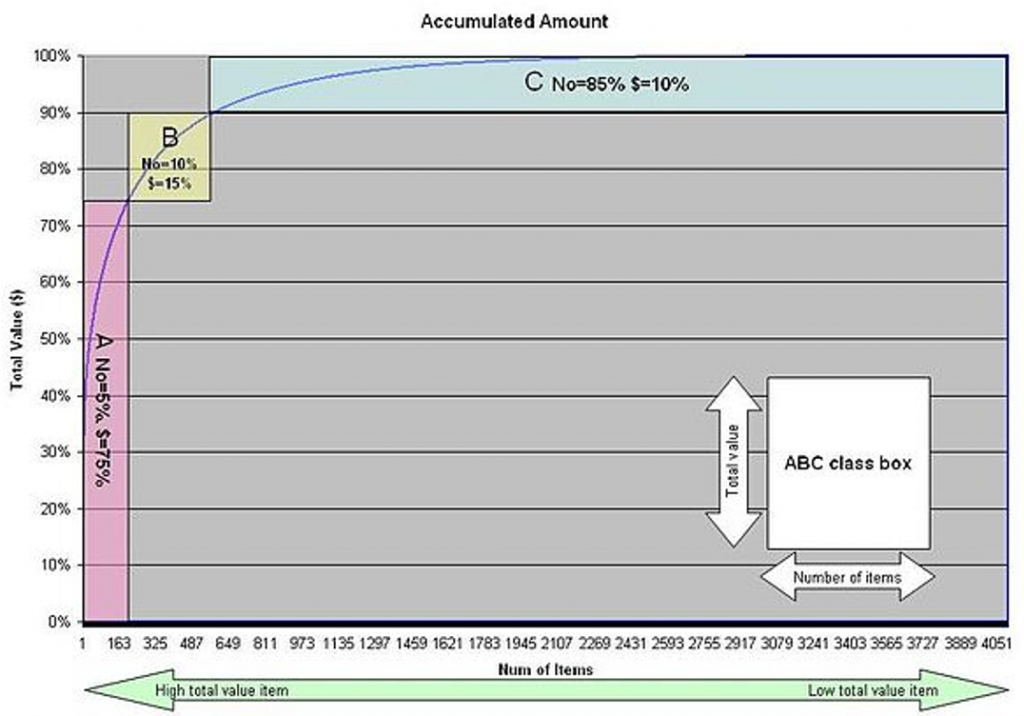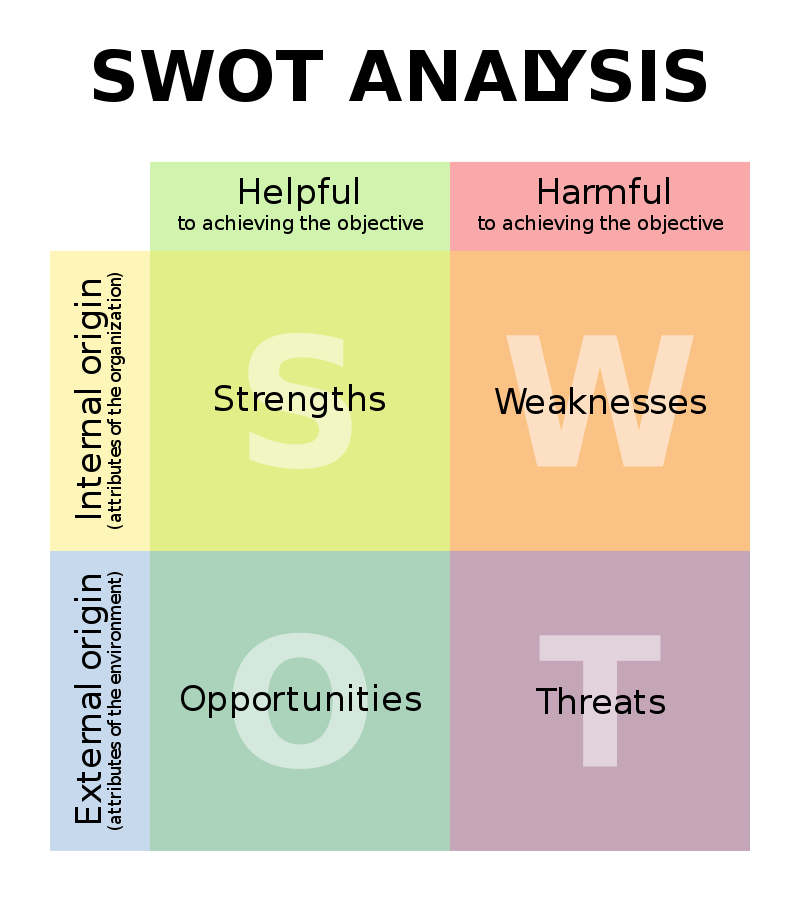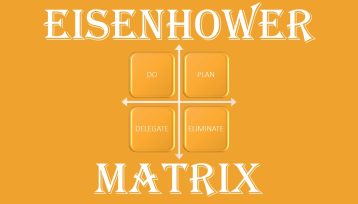After you finished the Environmental Analysis, it is time to go to the internal analysis of your company.
The analysis of the internal environment of the company is the analysis of strengths and weaknesses, as well as the assessment of the potential that the company can count on in the competitive struggle to achieve its goals.
The main objectives of the analysis are to determine the factors and causes of the strengths and weaknesses of the organization.
One of the tools for internal analysis is ABC analysis.
ABC analysis is a method that allows classifying the resources of the company according to their degree of importance. This analysis is one of the methods of rationalization and can be applied in the field of activity of any enterprise.
It is based on the Pareto principle – 20% of all goods give 80% of turnover.
The essence of this analysis is to select data and divide it into three categories according to importance. At the same time, completely different indicators can be taken as a basis.

ABC analysis gives you an opportunity to focus on tracking the most important sampling indicators for a company in order to increase the efficiency of both the management and operation of individual departments and the company as a whole.
Such analysis allows you to determine cumulatively the value shares of each of the goods sold, or the contribution of a particular company to the total turnover. Cost shares are calculated from their total cost of implementation for a specific period of time.
When conducting an ABC analysis, it is worth considering a number of factors:
- Include homogeneous groups in the analysis (comparing such groups as distributors and end users, as well as large consumers, should be done carefully)
- Select the correct interval for evaluation (month, quarter, year)
- Take into account the novelty (product, customer, supplier)
Usually carrying out an ABC analysis consists of the following steps:
- Definition of objects of analysis (products, customers, suppliers)
- Definition of analysis objectives. What we need the data for.
- Ranking of objects in descending order of parameter value.
- Calculation of the share of the parameter from the total amount with the cumulative total.
- Definition of groups A, B, and C.
Data is usually divided into the following proportions:
- A – important, 20% (of goods, customers) give 80% (of sales, turnover)
- B – necessary, 30% (of goods, customers) give 15% (sales, turnover)
- С – unimportant, 50% (of goods, customers) give 5% (of sales, turnover)
One of the most important tools for the internal analysis of a company is to study its own clients, including their satisfaction with the services and products of the company, as well as their willingness to recommend the company to their colleagues and partners.
In order to determine the level of consumer loyalty, Frederick Reichheld proposed a unique method. In 2003, in his article The One Number You Need to Grow published in the Harvard Business Review, he proposed a method for determining consumer commitment to a product, company, or brand.
The method is called NPS (Net Promoter Score), and it can be described as “the index of readiness to recommend.” This index is also used to assess readiness for continuous purchases.
The research method consists of the following steps:
- The company’s clients have to answer the question “What is the probability that you would recommend a company/product/ brand to your friends/acquaintances/ colleagues?” On an 11-point scale, where 0 corresponds to the answer “I will not recommend it in any way”, and 10 – “I will definitely recommend.”
- Based on the estimates obtained, all consumers are divided into 3 groups: 9-10 points – product/brand promoters, 7-8 points – neutrals or passives, 0-6 points – critics (detractors).
- Then you calculate the index
After the data on external and internal analysis have been obtained, it is necessary to conduct a SWOT analysis.
The SWOT analysis is a method of strategic planning, which consists of identifying the factors of the internal and external environment of an organization and dividing them into four categories:
- Strengths
- Weaknesses
- Opportunities
- Threats
Strengths and weaknesses relate to factors of the internal environment of the company, while opportunities and threats relate to the external environment factors of the company.

In the first case, the company can control and influence factors on its own, in the second case, the factors do not depend on the company’s actions, and it has to adapt to them.
Thus, a SWOT analysis is carried out in the following several steps:
a) Assessing the strengths and weaknesses of the company
The first stage allows you to identify the strengths and weaknesses of the enterprise. In order to accurately identify them, you must:
1) Prepare a list of criteria to evaluate the company
2) For each criterion to identify strengths and weaknesses
3) Identify the most important strengths and weaknesses in order to put them in the matrix of the SWOT analysis
b) Assessment of market opportunities and threats
The second stage allows you to evaluate the market. An assessment of the situation outside the company is carried out to identify opportunities, as well as to avoid potential threats. The method of identifying market opportunities and threats is similar to the method of identifying the strengths and weaknesses of a company:
1) Prepare a list of criteria to assess the market
2) For each criterion, we compile a list of opportunities and threats
3) The most important opportunities and threats go into the matrix
c) Comparison of the data obtained
At the third stage of the analysis, it is necessary to compare the obtained data on the strengths and weaknesses of the company, as well as the opportunities and threats from the market. This stage provides an opportunity to assess the future development of the company’s activities.
- How to use company strengths for market opportunities
- How can the company’s weaknesses affect it
- Avoiding market threats with company strengths
- What are the threats under the influence of the weaknesses of the company should be constantly kept in control
The main task of the SWOT analysis is a structured description of the situation regarding which you need to take a decision. The conclusions drawn from it are descriptive without recommendations and prioritization.
To obtain the most complete result from the SWOT analysis, you have to prepare options for actions that are formed on the basis of the intersection of the matrix fields. It is necessary to analyze all combinations of external and internal factors.

The SO field shows which strengths need to be used in order to gain value from opportunities in the external environment.
The WO field shows the possibilities of the external environment for an organization to overcome existing weaknesses.
The ST field shows which forces need to be used to eliminate the threats.
The WT field shows which weaknesses need to be eliminated in order to try to prevent an impending threat.
And after you are through with the internal analysis you go to the last but not least step of your strategic marketing.





